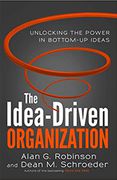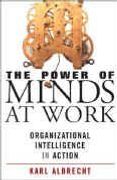
A 5 Minute Overview Of
The Idea-Driven Organization
Unlocking the Power in Bottom-Up Ideas
About the Authors
Alan Robinson is a professor in the School of Management at the University of Massachusetts. To date, he has co-authored six books including Ideas are Free, Corporate Creativity and Modern Approaches to Manufacturing Improvement. Dr. Robinson specializes in continuous improvement, creativity, ideas and innovation lean production. He has also consulted with more than 200 organizations in 25 countries. Dr. Robinson is a graduate of the University of Cambridge and Johns Hopkins University.
Dean Schroeder is professor of management at Valparaiso University. In addition to coauthoring Ideas Are Free, Dr. Schroeder has published 80 articles and consulted with organizations in North America, Europe and Asia. His work focuses on creating high-performing organizations and improving them through better management. Dr. Schroeder is a graduate of the University of Minnesota and the University of Montana.
The Main Idea
Fresh ideas for improving your business probably won't come from your senior managers — you're already doing what they think. Instead, the best ideas are far more likely to come from your front-line people who interact with customers, make your products and deliver your services. Instead of suppressing those ideas, idea-driven organizations pick up on them and apply them.

Simply put, idea-driven organizations are directed from the top but are primarily driven by ideas from the bottom. They let good ideas bubble up from front-line staff which then get picked up on and executed from the top down. For this to happen, you need to have systems in place which both push and pull those ideas at the same time.
To get ahead, don't look for a superstar CEO. Listen to and act on the ideas of your ordinary employees. When you start unlocking the potential of those ideas, everything changes.
The bottom line is this: Idea-driven organizations have many times the improvement and innovation capability of their traditional counterparts. If you learn how to tap the ideas of your front-line workers, you can truly break free of the reductionist "more with less" mindset. You and your employees will thrive in environments where you once would have struggled to survive.
Sections in this Books
1. Understand the power of front-line ideas. It's amazing how many companies ignore the ideas which their front-line employees generate every day. If you can become idea-driven, you can gain a competitive advantage.
2. Realize this will take a different kind of leadership. To become idea-driven, you're going to replace command-and-control with a better management style. You'll need systems which keep managers connected with front-line people so you can pick up on their ideas.
3. Start aligning your strategy and your management. To become idea-driven, you'll need to eliminate all the misalignments which stop great ideas from bubbling up from the bottom at the present time. Focus front-line ideas on your organization's key strategic goals and then make it possible for those ideas to flow.
4. Build and implement your front-line idea system. The nine steps involved in designing and launching a front-line idea system are:

5. Use front-line ideas to innovate. Once you put your front-line idea system in place, you have to keep it relevant. The key to doing this on an ongoing business is to link front-line ideas and innovations. Make it clear solving problems is everyone's job and that everyone is capable of coming up with innovative and useful ideas.
Want in-depth 30-minute summaries?
In addition to this 5-minute overview, Summaries.Com has a premium 30-minute summary of this book and 1,000+ more, to help you advance your career and business.
Check Out Summaries.com Premium Plans Today!Want more 5-minute Snapshots?
To get a new 5-minute business book snapshot each week, sign up for the Summaries.com free plan.
Sign Up for the Summaries.com Free PlanLeadership 2 Collection
If you enjoyed this summary, here is a collection of related business book summaries, to help you get ideas and strategies that will give you an edge over your competition.
This mini-course will help you lead better and excel.
Buy Leadership 2 Collection (5 x 30-Min Summaries)
The Idea-Driven Organization
Unlocking the Power in Bottom-Up Ideas
by Alan Robinson and Dean Schroeder

Nine Lies About Work
A Freethinking Leader's Guide to the Real World
by Marcus Buckingham and Ashley Goodall

The Power of Minds at Work
Organizational Intelligence In Action
by Karl Albrecht

The Power of Positive Leadership
How and Why Positive Leaders Transform Teams and Organizations and Change the World
by Jon Gordon

The Halo Effect
. . . And the Eight Other Business Delusions That Deceive Managers
by Phil Rosenzweig